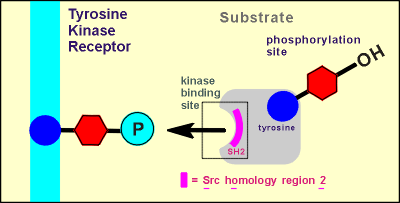 Substrates (or effectors) for tyrosine kinase receptors have three
characteristics:
Substrates (or effectors) for tyrosine kinase receptors have three
characteristics:  Substrates (or effectors) for tyrosine kinase receptors have three
characteristics:
Substrates (or effectors) for tyrosine kinase receptors have three
characteristics:
1. They possess at least one Src Homology Region 2 sequence, the so=called SH2 domain (see below)
2. Most are enzymes.
3. They are activated through phosphorylation of the hydroxyl group of tyrosine(s) within the substrate structure.
The Src Homology region 2 (SH2) domain of the substrate is important in receptor recognition, namely in targeting the substrate to the phosphotyrosine sites on activated receptors.
The TKR then phosphorylates the substrate on its tyrosine phosphorylation site and the substrate is now activated to bring about changes inside the cell.
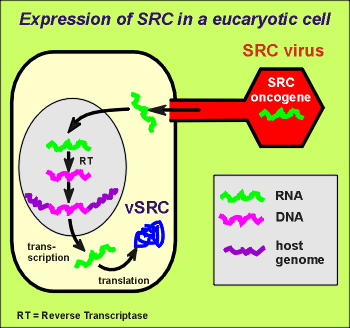 Src was originally discovered as the product of an viral oncogene.
Src was originally discovered as the product of an viral oncogene.
Oncogenes are genes of retroviruses (viruses which use RNA as genetic material)
The product of these genes have the potential to induce cancer, thus the name oncogenes (onco = tumor).
During an infection the viral RNA is transcribed into DNA (by reverse transcriptase).
The DNA is then incorporated into the host genetic material.
Viral products can then come to expression via normal transcription and translation.
The virus called Src possesses a gene which codes for the protein that induces cancer.
The gene has been given the name the Src oncogene and the protein product it codes for given the name Src or, more correctly, viral Src (vSrc) because it is the product of a virus.
Src causes neoplastic transformation in cells (uncontrolled cell division leading to tumor formation).
(More information on oncogenes can be found in the module Oncogenes in this tutorial).
 The
Src oncogene has been found to code for a large protein.
The
Src oncogene has been found to code for a large protein.
A number of regions were found within the protein which had sequence homology with regions found in other proteins.
For example, Src homology region 1 (SH1) has homology with the catalytic subunit of tyrosine kinases!
Indeed, Src has proved to be a tyrosine kinase! In fact Src has the distinction of being the first identified tyrosine kinase.
Src homology region 4 (SH4) has homology with a membrane binding domain found in other proteins.
Indeed, Src protein has proved to be associated with the membrane via the N-terminal.
The SH2 and SH3 domains (~100 and ~40 amino acids respectively) have been found to be involved in protein-protein interactions termed protein targeting.
 All substrates for tryosine kinase receptors possess an SH2 domain.
All substrates for tryosine kinase receptors possess an SH2 domain.
Further, it has been shown that it is the SH2 domain which targets the substrate proteins to the phosphotyrosines of TKRs.
This is the basis of substrate targeting to the kinase.
The SH3 domain is involved in the targeting of proteins to partner proteins with proline-rich domains.
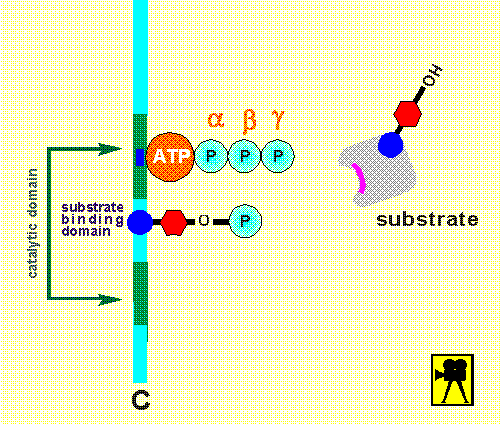
Like all kinases, tyrosine kinase receptors use the gamma phosphate group of ATP to phosphorylate their substrates.
 Keep in mind that the animations in this tutorial are highly schematic.
Keep in mind that the animations in this tutorial are highly schematic.
In reality a complex tertiary structure in the kinase and in the substrate would be involved in bringing the two proteins together.
A small step towards reality is perhaps depicted in the figure to the right.
Can you see what is going on here?
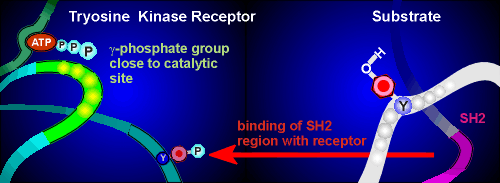 Perhaps this helps!
Perhaps this helps!
.
.
.
.
.
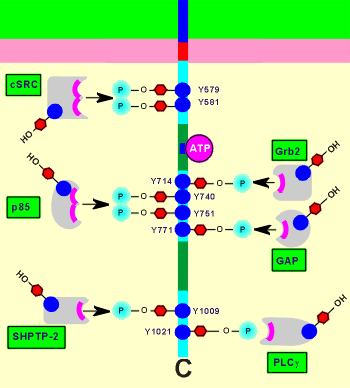 To the right is a representation of the
intracellular region of the PDGF receptor together with the substrates for the kinase.
To the right is a representation of the
intracellular region of the PDGF receptor together with the substrates for the kinase.
Each substrate has its own specific binding site within this receptor kinase.
For example, it has been shown by site-directed mutagenesis (whereby specific amino acids can be knocked out of a protein) that a PDGF receptor missing tyrosines 740 and 751 fails to bind and phosphorylate the P85 protein.
The ability of this PDGF receptor to bind and phosphorylate all its other substrates is unaffected by this mutation.
The names and functions of some of these TKR substrates is the subject of the next module of this tutorial, TKR Function.
Note that one of the substrates for the PDGF receptor is cSrc.
cSrc is cellular Src, a normal product of eucaryotic cells.
It is structurally related to vSrc but has two SH2 domains instead of the single SH2 domains of vSrc.
How a normal product of the eucaryotic genome and the product of a viral oncogene can be related is explained in the module "Oncogenes".